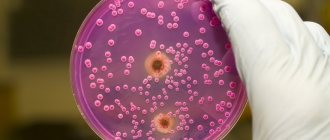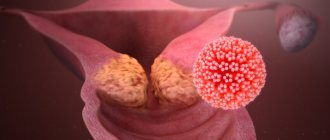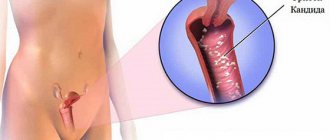A flora smear is the most important analysis when determining the state of a woman’s intimate health.
Since it is the main method for diagnosing diseases such as gonorrhea, trichomoniasis, chlamydia and a number of other equally dangerous bacterial infections.
In addition, a smear on the flora can help in diagnosing hormonal imbalances, acid-base balance disorders, allergic reactions, and even overdose or poisoning of certain substances, since the flora of the genital organs also responds to these disorders.
Expert opinion
Kovaleva Elena Anatolyevna
Doctor-Laboratory Assistant. 14 years of experience in clinical diagnostic services.
Ask a question to an expert
A smear on the flora is performed from the vagina, urethra and cervix , because each of these organs has its own microflora, different from the microflora of other organs.
Usually a healthy woman needs to undergo this procedure once a year to make sure that there are no pathological changes, but for diseases of the genital organs, the analysis must be done more often in order to monitor the effectiveness of treatment and adjust it if necessary.
What does the study show?
An analysis of the flora of the genital organs shows the number of microorganisms of different types , the number of dead epithelial cells lining the cavities of the organs from which a smear is taken, and the ratio of these types of cells to each other.
Expert opinion
Kovaleva Elena Anatolyevna
Doctor-Laboratory Assistant. 14 years of experience in clinical diagnostic services.
Ask a question to an expert
Flora analysis reveals cells that cause dangerous diseases, their fragments, as well as changes in the epithelial cells of the female body. All this allows us to diagnose diseases of the female reproductive system with high accuracy.
https://youtu.be/P6xFi96zu5M
Video on the topic
https://youtu.be/7cE8-xPoKYI
You need to visit a gynecologist once every six months. This will keep women’s health under control and identify diseases in time. The simplest and most accessible research method in gynecology is taking a gynecological smear.
Deciphering such an analysis will allow the doctor to see changes in the woman’s reproductive system that are not visible during an external examination.
- Taking a smear is a completely painless procedure and will only take a couple of minutes. It does not pose a health hazard and can be performed even on pregnant women.
Norm of indicators in the table
Normal flora indicators differ for the cervix, urethra and vagina. Let's look at the main indicators in the table.
| Indicators | Normal values |
| For the vagina: | |
| Gonococci | No |
| Trichomonas | No |
| Key cells | No |
| Mushrooms | No |
| Slime | A small amount of |
| Microflora | Dederlein sticks |
| For the cervix: | |
| Gonococci | No |
| Trichomonas | No |
| Key cells | No |
| Mushrooms | No |
| Slime | A small amount of |
| Microflora | No |
| For the urethra: | |
| Gonococci | No |
| Trichomonas | No |
| Key cells | No |
| Mushrooms | No |
| Slime | No |
| Microflora | No |
Thus, normally only the vagina is inhabited by microflora .
Indications for the study
A healthy vaginal environment mainly consists of lactobacilli, the so-called Dederlein rods. A small part is occupied by other microorganisms, including opportunistic ones. Under certain conditions, they begin to actively grow and become the cause of inflammatory diseases and infections of the genitourinary system. Some microorganisms enter the vagina from the outside and cause genital infections:
- Trichomonas;
- herpes and human papilloma viruses;
- gonococci.
That’s why it’s so important to do a microflora culture in time. Indications for the purpose of analysis are:
- inflammatory processes in the vagina, accompanied by itching;
- secretion of large amounts of mucus;
- if STI infections are suspected;
- to monitor treatment;
- taking hormones, contraceptives;
- medical examinations;
- pregnancy.
In order to detect diseases and inflammatory processes in time, every woman is advised to have a smear test at least once every twelve months.
Smear for flora and sensitivity to antibiotics
In addition to diagnosing diseases of the reproductive system, a smear on the flora helps determine sensitivity to antibiotics. This method, in addition to simple examination under a microscope, involves growing a culture on a nutrient medium.
For this reason, the method is more expensive than simple research (the nutrient medium is consumed) and requires time. But it allows you to determine how sensitive various microorganisms from the microflora of a particular woman are to different types of antibiotics. This is necessary in order to prescribe the safest antimicrobial treatment.
The method boils down to the following: microflora is taken in the same way as in other tests, but placed on a nutrient medium. colonies of microorganisms appear on the nutrient medium , which are tested for sensitivity to various types of antimicrobial drugs.
The drug to which beneficial microflora is less sensitive is usually used.
Purity
A smear for the degree of purity, norms for women, table, also needs to be considered. Depending on the results obtained during the study, the doctor determines one of four degrees of purity. If the smear is normal for the degree of purity, then a unit is set. The biomaterial corresponds to the correct content of leukocytes, multiple contents of Dederlein rods, a moderate amount of mucus and epithelium.
In the second degree, a normal content of leukocytes is noted; beneficial lactobacilli are present in the same quantity as the coccal flora. The content of mucus and epithelium is moderate. This condition is considered normal, but it is necessary to increase the protective abilities of local immunity in order to prevent the development of the inflammatory process.
In the third degree, the level of leukocytes exceeds the norm, and the main representatives of the vaginal microflora are pathogenic (pathogenic) bacteria, including many yeast-like fungi and cocci, the level of beneficial lactobacilli is critically reduced. The woman has a large number of epithelial cells, as well as mucus. In this situation, the doctor diagnoses an inflammatory process that requires proper treatment.
In the fourth degree, the level of leukocytes is too high, lactobacilli are absent, and pathogenic microflora is too predominant, there is a lot of epithelium and mucus. In this condition, the patient is diagnosed with a severe inflammatory process and immediate treatment is started.
Symptoms of microflora disorders
What characterizes the change in the microflora of the genital organs and how to determine it in yourself? In a normal state, a woman’s vagina is inhabited by lactobacilli, Dederlein bacilli and bifidobacteria, as well as key vaginal cells, of which only 1%. These are Gardinella, Leptothrix and other representatives of the pre-nuclear superkingdom. Normal microflora does not cause any discomfort, redness or other symptoms, existing in “peace” with the body and preventing the proliferation of other microorganisms.
If instead of harmless bacteria, dangerous microorganisms begin to develop in the vagina, this causes irritation of the vaginal walls and leads to burning, pain, itching and similar sensations, which are especially often observed during sexual intercourse.
- When Gardinella actively multiplies, profuse vaginal discharge occurs with the smell of rotten fish, itching and burning, which intensifies during sexual intercourse or urination.
- Leptothrix causes the appearance of gray spots and small gray discharge on the walls of the vagina. At the same time, the body becomes more vulnerable to trichomoniasis.
- An increase in the number of mobiluncus is dangerous during pregnancy, as these bacteria secrete enzymes that rupture the membranes. Causes a rotten fish stench, white discharge, etc.
- Cocci cause dangerous inflammation of the pelvic organs, rising from the vagina to the uterus and ovaries. In extreme cases, they can cause infertility. Symptoms: toxic shock, ammonia smell, pain.
Medicines that cause changes in flora
Changes in the vaginal microflora occur as a result of taking antimicrobial drugs. The fact is that their action is aimed not only at harmful, but also at beneficial microorganisms that live on the mucous membranes.
The first group of such drugs is antibiotics. These are medications used for sore throat, otitis media, pneumonia and many other diseases. They disrupt the metabolism of bacteria, causing their death and thus leading to dysbacteriosis. These are drugs such as gentamicin, tetracycline, aminoglycosides, levomycin, and so on. The wider the spectrum of action of antibiotics, the greater the likelihood that dysbiosis will develop after a course of treatment.
The second large group of drugs whose action is directed against bacteria are sulfonamides. These are biseptol, streptocide , etc. They are not as dangerous as antibiotics, and can only cause dysbiosis with long-term use or overdose.
Fluoroquinolones are the third group of antimicrobial drugs. This includes ciprofloxacin, etc. They are also less dangerous than antibiotics, and the reaction to drugs in this group depends on the individual characteristics of the body.
Diseases that cause changes in flora
There are a number of diseases whose pathogens are capable of displacing normal microflora from the vaginal mucosa. This is a disease that is transmitted both sexually and domestically. This disease causes profuse yellow discharge, itching, burning and redness. The causative agent of this disease, Trichomonas, causes microflora disruption in 96% of cases , reducing the number of lacto- and bifidobacteria. Pathogenic bacteria, on the contrary, coexist perfectly with Trichomonas.
The next disease that affects the genital mucosa is gonorrhea, or gonorrhea. It is caused by gonococci and is characterized by the formation of a large amount of pus, which affects the microflora and is actively released. Gonorrhea is a dangerous disease that can lead to infertility and even death.
A disease such as chlamydia, which can also lead to changes in microflora and purulent vaginal discharge, is also common. In addition to damage to the genital organs, the causative agents of the disease, chlamydia, also cause symptoms of poisoning - fever, headache, etc.
Expert opinion
Kovaleva Elena Anatolyevna
Doctor-Laboratory Assistant. 14 years of experience in clinical diagnostic services.
Ask a question to an expert
Among non-infectious diseases, the vaginal microflora is affected by various forms of allergies. Moreover, you can even be allergic to your sexual partner during unprotected sex, as well as to certain types of condoms, underwear, etc.
Decoding the results of men
In most cases, no special preparation is required for taking a smear, but to ensure that the test results are as accurate as possible, some rules still exist:
- 3 days before taking a smear, a woman should refuse sexual intercourse or use a condom - this is necessary so that male seminal fluid is not detected when studying the smear;
- flora smears are not taken during menstruation or in the first 2 days after it - this may affect the reliability of the results;
- in the morning, on the eve of the procedure, you should thoroughly clean the external genitalia;
- do not empty your bladder 2 hours before taking a smear - urine can wash away all pathogenic bacteria and fungi from the mucous membranes, as a result of which the test result will be unreliable;
- do not douche or use antibacterial soap 2-3 days before taking a smear - this can also lead to incorrect smear results;
- take a smear before using any vaginal suppositories, tablets, or ointments.
MORE ABOUT: Is Methyluracil an Antibiotic or Not?
A woman’s flora smear is performed during a routine or emergency examination by a gynecologist. Position of a woman lying on her back on a gynecological chair.
Using a special wand brush, the doctor takes a sample of discharge from the urethra, cervical canal and vagina. A sample of mucus is applied to a clean glass slide, which is then examined under a microscope.
In some cases, if necessary and if an infection is suspected, to clarify the causative agent of the disease, a smear is sown on a nutrient medium.
When studying a smear for microflora, attention is paid to the presence and quantity of such indicators as:
- epithelial cells;
- leukocytes;
- Doderlein sticks;
- mushrooms;
- pathogens of sexually transmitted infections (Trichomonas, gonococcus, ureaplasma, mycoplasma);
- slime;
- key cells (modified, atypical).
The urethra, cervical canal and vagina may contain different amounts of these components; the norms are presented in more detail in the table.
Table - normal smear indicators for microflora in a healthy adult woman
| Smear readings | Contents in the urethra | Contents in the vagina | Contents in the cervical canal |
| Leukocytes | 0 to 5 in view | Up to 8-10 in sight | 12 to 28 in view |
| Epithelial cells | Up to 5-10 in sight | Up to 10 in sight | Up to 10 in sight |
| Yeast-like fungi Candida | Not found | None | None |
| Slime | Present in moderate amounts | Present in moderate amounts | Present in moderate amounts |
| Gonococci, Trichomonas, Ureaplasma, Mycoplasma, Escherichia coli | Not found | Not found | Not found |
| Key cells (atypical) | Not found | Not found | Not found |
| Dederlein sticks | Not found | Found in large numbers (lactobacillus) | Not found |
Separately, it should be said about Dederlein's bacilli (vaginal lactobacilli). Their number in the vagina of a healthy adult woman determines the degree of vaginal cleanliness, of which there are only four:
- 1st degree of purity - is an ideal option, there are a lot of Dederlein rods in the smear, several epithelium and leukocytes in the field of view;
- 2nd degree of purity - the most common option, leukocytes are normal, mucus and epithelial cells are in moderate quantities, there are a sufficient number of Dederdein rods in the vagina;
- 3rd degree of purity - the smear reveals a large amount of mucus, leukocytes and epithelium, sometimes fungi of the genus Candida can be detected, there are few lactobacilli;
- 4th degree of purity - there are very few or no lactobacilli, there are a lot of leukocytes and epithelial cells, fungi of the genus Candida are present in large quantities, pathogenic agents of infection can be detected.
If degrees 1 and 2 of vaginal cleanliness are normal, then degrees 3 and 4 indicate the presence of a serious inflammatory process in the pelvic organs, indicates vaginal dysbiosis and requires immediate treatment.
Minor errors in the results do occur and are often caused by improper preparation for the smear, insufficiently thorough genital hygiene, douching the day before or sexual intercourse.
During the entire period of bearing a baby, a woman takes a smear test for flora at least 3 times: when registering, before going on maternity leave at 30 weeks, and immediately shortly before the expected date of birth.
A flora smear examines indicators such as leukocytes, epithelium, microflora, infections (trichomoniasis, gonorrhea, candidiasis), mucus and key cells. Let's figure out what normal and pathology mean in this analysis and how to decipher it.
| Indicators | Urethra (normal) | Vagina (normal) | Cervical canal (normal) |
| Leukocytes | 0-5 in p/z | 0-10 in p/z | 0-15-30 in p/z |
| Epithelium | Moderate or 5-10 in p/z | Moderate or 5-10 in p/z | Moderate or 5-10 in p/z |
| Slime | Moderate/absent | Moderately | Moderately |
| Gonococci | Not found | Not found | Not found |
| Trichomonas | Not found | Not found | Not found |
| Yeast fungi (Candida) | Not found | Not found | Not found |
| Microflora | absent | rods in large quantities or lactobacillary | absent |
| Key cells | none | none | none |
For the urethra, vagina, and cervical canal, as mentioned above, there are normal indicators. For the urethra: leukocytes should be normal from 0 to 5 in the field of view, epithelium is moderate or from 5 to 10 or 15 in the field of view, mucus should be absent, any infections (candidiasis, trichomoniasis, gonorrhea) and bacteria should not be normal must.
An increase in the levels of leukocytes and epithelium in the urethra indicates an inflammatory process or urethritis, urolithiasis, mechanical damage to the urethra with a stone, sand or foreign object, which requires immediate consultation with a doctor.
Detection of gonococci, trichomonas and Candida fungi indicates specific urethritis. Increased mucus in the analysis is possible due to violation of hygiene rules and improper collection of biomaterial.
| Indicators | Urethra (normal) |
| Leukocytes | 0-5 in p/z |
| Epithelium | 5-10 in p/z |
| Slime | Moderate amount |
| Cocci | single |
| Yeast mushrooms | none |
| Gonococci | none |
| Trichomonas | none |
Deviations from the norm are a serious reason to consult an andrologist or urologist, who will accurately diagnose and prescribe treatment. It should again be noted that it is necessary to take into account the laboratory reference values, which may be indicated nearby in the right column.
MORE ABOUT: Toxogenic granularity in a general blood test
In the results of a smear on the flora in men, the number of leukocytes should normally be from 0 to 5 in the field of view, epithelium from 5 to 10 in the field of view, cocci are present in a single amount, mucus in a moderate amount, and trichomanadas, gonococci, and fungi are absent.
Deviations from the above norms indicate a pathological process or inflammation. Leukocytes are one of the main indicators that indicate to the doctor the degree of inflammation and pathology of the organs of the urogenital tract. They may be elevated in the following diseases:
- specific or nonspecific urethritis;
- prostatitis;
- urolithiasis disease;
- the presence of benign and malignant neoplasms;
- stricture (narrowing) of the urethra.
An increase in the epithelium also indicates an inflammatory process or urolithiasis, and the detection of cocci approximately higher than 4-5 in the field of view means the presence of acute or chronic nonspecific urethritis caused by opportunistic bacteria.
Large quantities of mucus also indirectly indicate inflammation, but with normal other indicators it can indicate sluggish urethritis or prostatitis.
Interpretation of a smear for flora in women includes the following data: epithelial indicators, mucus assessment, the presence of gonococci, Trichomonas and Candida fungi, as well as an assessment of the number of Dederlein bacilli.
| Study | Normal in the vagina, Vag (V) | Normal in the urethra, Ur (U) | Normal cervix, Cer (C) |
| Leukocytes | up to 20 | to 10 | up to 30 |
| Epithelium | Insignificant | Insignificant | Insignificant |
| Microflora | Many Derdeline sticks | — | — |
| Gonococci | — | — | — |
| Trichomonas | — | — | — |
| Key cells | — | — | — |
| Candida | — | — | — |
| Slime | Moderate | — | Abundant |
Leukocytes are blood cells that can protect the body from viruses and bacteria. If the level of leukocytes increases, this indicates inflammatory processes in the genital or urinary organs.
If the leukocytes in the smear exceed the permissible norms, this may indicate inflammation of the mucous membrane of the vagina (colpitis), uterus (endometritis), and uterine appendages (adnexitis). It is also possible to increase the number of white blood cells in the urethra due to inflammation of the urethra (urethritis).
Epithelium. The internal genital organs of a healthy woman are covered with a thin layer of epithelial cells. If the amount of epithelium exceeds the norm, this indicates hormonal imbalances.
In this case, the desquamation of the internal mucous membrane is disrupted, and several balls of epithelial cells are formed one on top of the other. In case of increased levels of epithelium in the flora smear, a cytological examination is prescribed.
Consequences of changes in flora
As a result of changes in the microflora of the genital organs, the natural barrier to harmful microorganisms disappears, which immediately begin to multiply. As a result, a few days after the onset of changes, inflammation or small wounds (erosions) may already occur, gradually spreading to the entire mucous membrane and leading to serious complications.
In addition, healthy microflora reduces the likelihood of contracting STDs , and its absence facilitates the penetration of pathogens of these infectious diseases into the body.
And finally, healthy microflora is important from a purely hygienic point of view, because if the composition of microorganisms is stable, there is little discharge from the vagina, they do not contaminate the laundry and do not smell.
Preparing for analysis
To ensure your results are as accurate as possible, there are a few things you need to do to prepare your body for the smear test.
- Abstain from sexual intercourse 48-72 hours before your appointment.
- Discontinue any treatment involving vaginal administration of medications.
- Before the procedure, toilet the external genitalia.
- Before bacterioscopy, do not urinate for 2-3 hours.
The menstrual cycle can affect the number of white blood cells in the microscope's field of view. Therefore, the ideal period for taking a smear would be 4-5 days of the cycle. That is, immediately after menstruation. If you cannot choose a period, then you just need to inform your doctor about the current day of the cycle.
How to restore normal microflora?
Whatever causes the change in the vaginal microflora, it can be restored using various medications, hygiene products and correction of one’s lifestyle.
- If pathogenic microflora has already developed in place of normal microflora, you need to start by eliminating it. For this purpose, special suppositories or tampons soaked in medicinal solutions are used. All remedies are used only as prescribed by a doctor, otherwise things can get worse.
- The underwear during the entire treatment period should be linen or cotton .
- If pathogenic microbes, causative agents of STDs, are detected, the sexual partner must also be examined and treated if he is also sick.
- If you are allergic to condoms, pads, etc., the source of the allergen must be eliminated and no longer used.
- It is important to keep your genitals clean, using special soaps, creams, etc., selected specifically for you. At least until complete recovery.
- Finally, watch how you eat. Sometimes a lack of vitamins or minerals can affect the microflora.
- While you are taking antibiotics, normalization of the microflora is unlikely, but after stopping the drugs it can happen without your intervention .










